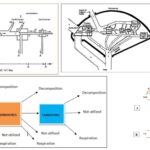AQA GCSE Biology 30 Views 1 Answers
Sourav PanLv 9November 13, 2024
What are the different hormonal and non-hormonal methods of contraception, and how do they work to control fertility?
What are the different hormonal and non-hormonal methods of contraception, and how do they work to control fertility?
Please login to save the post
Please login to submit an answer.
Sourav PanLv 9May 15, 2025
Contraceptive methods can be categorized into hormonal and non-hormonal types, each functioning through different mechanisms to control fertility. Here’s a detailed overview of these methods:
Hormonal Methods
Hormonal contraceptives work primarily by altering the hormonal balance in the body to prevent ovulation, thicken cervical mucus, and thin the uterine lining. They include:
- Combined Oral Contraceptives (COCs):
- Description: Pills containing both estrogen and progestin.
- Mechanism: Suppress ovulation, thicken cervical mucus, and thin the endometrial lining to prevent implantation.
- Progestin-Only Pills (Mini-Pills):
- Description: Pills containing only progestin.
- Mechanism: Primarily thickens cervical mucus and may prevent ovulation.
- Hormonal Intrauterine Devices (IUDs):
- Description: T-shaped devices inserted into the uterus that release progestin.
- Mechanism: Thicken cervical mucus and thin the uterine lining; some may also inhibit ovulation.
- Implants:
- Description: Small rods placed under the skin of the arm that release progestin.
- Mechanism: Prevents ovulation and thickens cervical mucus.
- Injectables:
- Description: Progestin injections (e.g., Depo-Provera) administered every three months.
- Mechanism: Prevents ovulation and alters cervical mucus.
- Patch:
- Description: A transdermal patch that releases estrogen and progestin.
- Mechanism: Similar to COCs, it prevents ovulation and thickens cervical mucus.
- Vaginal Ring:
- Description: A flexible ring placed in the vagina that releases hormones.
- Mechanism: Delivers hormones similar to COCs to prevent ovulation.
Non-Hormonal Methods
Non-hormonal contraceptive methods do not involve hormones and typically work by creating a physical barrier or using natural methods to prevent pregnancy:
- Barrier Methods:
- Condoms (male and female): Prevent sperm from entering the uterus; also protect against STIs.
- Diaphragm/Cervical Cap: Inserted into the vagina to cover the cervix; used with spermicide to block sperm.
- Copper IUD:
- Description: A non-hormonal device inserted into the uterus.
- Mechanism: The copper acts as a spermicide, preventing sperm from fertilizing an egg.
- Natural Family Planning (NFP):
- Involves tracking menstrual cycles to identify fertile days and abstaining from intercourse during those times. This method requires careful monitoring but has a higher failure rate compared to other methods.
- Withdrawal Method (Coitus Interruptus):
- Involves withdrawing before ejaculation; however, it is less effective due to pre-ejaculatory fluid potentially containing sperm.
- Abstinence:
- The only method that guarantees 100% effectiveness against pregnancy and STIs by avoiding all sexual activity.
- Spermicides:
- Chemical substances that kill sperm, often used in conjunction with barrier methods for increased effectiveness
0
0 likes
- Share on Facebook
- Share on Twitter
- Share on LinkedIn
0 found this helpful out of 0 votes
Helpful: 0%
Helpful: 0%
Was this page helpful?




